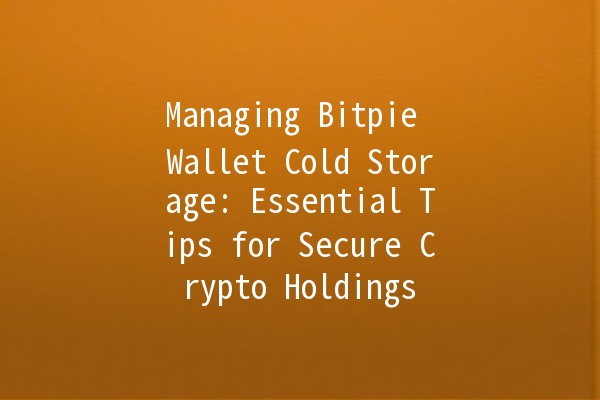
As cryptocurrency continues to gain traction, ensuring the security of your digital assets has never been more crucial. One of the most effective methods for safeguarding your cryptocurrencies is through the use of cold wallets. In this article, we will explore the management of Bitpie Wallet cold storage, offering practical advice and techniques that will help you enhance your security practices.
Understanding Bitpie Wallet and Cold Storage
What is Bitpie Wallet?
Bitpie Wallet is a popular cryptocurrency wallet designed for ease of use, catering primarily to users who wish to manage their Bitcoin and other cryptocurrencies securely. Bitpie focuses on usability while also offering enhanced security measures, making it a goto choice for many crypto enthusiasts.
What is a Cold Wallet?
A cold wallet refers to a type of cryptocurrency storage that is not connected to the internet, providing a layer of security against online threats such as hacking. Cold wallets can come in various forms, including hardware wallets, paper wallets, and even airgapped computers. The key benefit of using cold storage is reduced exposure to risks associated with online vulnerabilities.
Reasons to Use Cold Wallets

Tips for Effective Management of Bitpie Wallet Cold Storage
There are various ways to implement cold storage, such as hardware wallets and paper wallets. Each has its pros and cons. Hardware wallets like Ledger or Trezor are often praised for their security and ease of use. Paper wallets, on the other hand, are completely offline and can be created using secure methods.
Application Example: If you're uncertain about investing in a hardware wallet, start with a paper wallet generation from a secure offline computer and follow best practices to keep it safe.
Always secure your Bitpie Wallet with a strong password and enable twofactor authentication where possible. This is particularly important for any online operations you perform with your wallet before transferring assets to cold storage.
Application Example: Use a combination of upper and lower case letters, numbers, and symbols to generate strong passwords. Consider using a reputable password manager to store these securely.
Backups ensure that you can recover your wallet if your device is lost or damaged. Bitpie Wallet provides a recovery seed phrase that must be written down and stored securely.
Application Example: Write down your recovery seed phrase on paper and store it in a safe deposit box. Avoid digital storage for these sensitive pieces of information.
Phishing remains one of the most common methods used by attackers to gain access to wallets. Be cautious of unsolicited communications and only use the official Bitpie Wallet website or application.
Application Example: Regularly train yourself on identifying phishing emails or messages. You can practice by searching for recent phishing attempts online to familiarize yourself with common tactics.
If you choose to use a hardware wallet, make sure the environment is secure during the setup and transaction process. Avoid using public networks or unsecured devices.
Application Example: Use a dedicated computer that is offline for transactions related to your cold wallet. This decreases the chances of exposure during setup and fund transfers.
FAQs Regarding Bitpie Wallet Cold Storage Management
To transfer your crypto to cold storage, first ensure your Bitpie Wallet is set up properly. Then, send your coins from your exchange or online wallet to your Bitpie Wallet address. After ensuring the transfer is successful, consider transferring significant amounts to a cold wallet for longterm storage.
Losing your recovery seed phrase can mean the irreversible loss of your assets. If you have a backup that is securely stored, use it to recover your wallet. Otherwise, unfortunately, your access to those funds may be permanently lost.
Bitpie Wallet is considered secure, especially when using cold storage methods. However, the overall security will depend on how you manage your passwords, twofactor authentication, and backup processes. Always stay updated on best practices.
Yes, you can manage assets in cold storage and utilize Bitpie Wallet for transactions by moving amounts you need into your hot wallet, maintaining security for the majority of your funds in cold storage.
If your hardware wallet is damaged, you can recover your funds using the recovery seed phrase. Ensure you have stored this phrase securely prior to the wallet becoming damaged.
Bitpie Wallet itself does not charge fees. However, transaction fees may apply when sending or receiving cryptocurrencies, depending on the specific crypto network’s rules.
Staying Safe in a Digital Age
Managing Bitpie Wallet cold storage effectively requires awareness and careful implementation of security practices. By selecting a reliable cold storage method, using strong authentication measures, and educating yourself about potential risks, you can enhance the overall security of your cryptocurrency holdings.
Through proactive steps and regular maintenance of your cold storage wallet, you can enjoy peace of mind knowing your investments are significantly more secure from potential threats. Always remain diligent, continually update your knowledge, and adapt to new security standards as the cryptocurrency landscape evolves.

